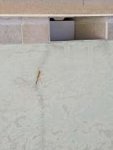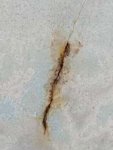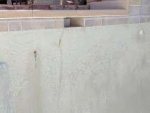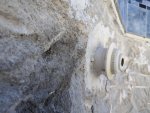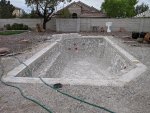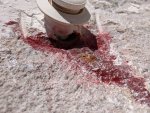So we have an IG gunite pool that we inherited with the purchase of our home hear in Las Vegas. We have owned the home for 8 years the pool was built in 2002, we have not had any problems with the pool since our purchase. We have replaced the old filter canister and pump and upgraded to a variable speed pump (Pentair Inteleflow) back in 2013 a year after our purchase. This past Febuary I noticed a rust stain and crack in the plastering just below the skimmer box (pictures attached). This pool had never been re-plastered in 18 years and was looking old and tired, and the decking was starting to chip away in spots and around the coping. So after having a few contractors out to assess the crack my wife and I decided to just bight the bullet and do a complete remodel of the pool decking and re-tile and plaster the pool. We are removing the concrete decking and coping and replacing with Belgard pavers and coping, this part of the project is mid way through and is looking pretty good so far we are very pleased with the paver contractor, the tile and coping look great, the pavers are being set as I type this and will be finished by weeks end. The issue we are having is with the re-plaster company, and I'm not sure if I fully agree or trust what the project manager is telling me with regards to 2 issues. The pool was chipped out about 12 days ago, during that process they chipped off or knocked off one return jet leaving just the stub pipe (which has no threads inside or out just a pipe) exposed through the gunite wall. I had a leak detection company come out and do a pressure test on the system since there was a lot of jack hammering around the pool during the removal of the old concrete decking/coping just in case there was any leaks created by the demo crew, all is good with the system accept for 2 other fittings. One return jet fitting and the suction fitting were determined to have very small leaks in the distal end of the fittings that the leak detection company says probably occured during the chip out.. This is an 18 year old pool and the fittings that were placed on the stub pipes are very odd in their design and are apparently obsolete now (pictures attached). The plaster company PM says there is no way his chip out crew cracked the fittings, the leak detection guy says its the fitting themselves that are leaking not the stub pipe. In the contract with the plaster company they were to replace the jets after re-plastering the pool, according to the PM that consists of just replacing the eyelets on the fittings not the fittings. I really don't have a problem with that accept he started saying that if the fittings are leaking they won't warranty the plaster job. Here is the situation I just wan't to remove and replace all of the fittings arounf the pool, 5 in total, I will pay for this on my own to make sure that once the plaster goes in that I don't have any issues down the road. Once replaced I will redo the pressure test again to make sure there are no more leaks detected. Need some advice on how to accomplish replacing all the return fittings, what would be the best way to remove the old fittings without damaging the stub pipe, and which fittings should I use to replace them. Was thinking of using a slip in fitting that has threads to accommodate the new eyelets and suction valve cover. The next issue I have with the re-plaster company is that after the chip out the crew rinsed down the wall to facilitate removing all the debris in the pool and there are several areas of the exposed gunite that have significant rust stains. There doesn't appear to be any rebar pushing through these areas. During the initial bidding process the PM said that it is no big deal that they grind back the gunite and patch the area with some sort of epoxy or cement before plastering. However, the crew that did the chip out just sprayed all of the ares with rustoleum spray paint and said that will prevent any rust from coming through the new plaster. When I have tried to speak with the PM about this his response is less than informational. My understanding is that these areas need to be cut back to the affected rusty rebar, cleaned and sealed, and then patched with concrete or epoxy or some combination of that to prevent any further rusting issues. When I spoke to the PM he says he will discuss it with the the team, but I get the feeling that they intend on blowing this issue off and just re-plastering the pool with the spray paint fix. Again I understand that they couldn't know what the surface was going to look like after the chip out, but this is their business, and I would like to think that they abide by some sort of industry standard. I just wan't to make sure that everything is done right and there will be no issues cropping up down the road. I am still waiting to here from the re-plaster PM about how this will be addressed, he will be out to do a final inspection of the pool prep prior to the plastering once the pavers are fully installed hopefully with in a week or so. Again I have no problem paying extra to have it mitigated correctly, but what should I expect to be done to make sure it is done right. Any insight would be greatly appreciated.
Complete remodel/replastering questions, any insight and advice would be greatly appreciated.
- Thread starter p.w.haney
- Start date
You are using an out of date browser. It may not display this or other websites correctly.
You should upgrade or use an alternative browser.
You should upgrade or use an alternative browser.
Hi! I am sorry we are meeting under these circumstances  I am going to call in a couple of people who might have some ideas. @jimmythegreek @bdavis466
I am going to call in a couple of people who might have some ideas. @jimmythegreek @bdavis466
Kim
Kim

Exposed rebar is addressed in few ways depending on the company. Some choose to just cut out section and paint, others will cut out section, paint, and apply various products over rebar before plaster. The fitting that came off is a flange fitting and they are still available, they just glue over the return pipe and then a new screw in return fitting will be installed. They can be removed and a slip return fitting used in the existing pipe and the flange is not needed. Change to new fitting like the one attached that is all in one.
AquaStar Pool Products | Flush-Mount Return Fitting with Water Stop, Eyeball and Nut (Fits 1" or 1½" Pipe)
AquaStar Pool Products | Flush-Mount Return Fitting with Water Stop, Eyeball and Nut (Fits 1" or 1½" Pipe)
You're the one cutting the check. If they aren't doing what you want then send them on to the next job.
The rebar is not actually exposed after the chip out. Just discovered 6 more rust stains in various spots of the gunite after the chip out, , this suggests to me that there are some rust issues within the wall that need to be addressed. The only spot that was visible prior to starting this whole project was the rusted cracked area below the skimmer in the photo. The plaster PM is kind of dancing around the issue with regards to how they are going to address the issue. I wan't to give them the benefit of the doubt, but I'm not getting a good feeling about his limited responses. He will be on site once the pavers are all in to do a pre plaster inspection, I will nail him down at that meeting. If he starts hemming and hawing about how they will address the issue, or implies that it isn't necessary I may have to let them go, and find someone else to do the plastering. So is it the industry standard to grind or cut back these areas and address the source of the rust, or just paint over the rusty spots on the gunite wall and plaster over that which is what I think they are planning to do. With regards to the return fittings what would you suggest as to the easiest way to remove all the old fittings so that new ones can be placed on the stub pipes prior to the re-plaster. I see your in Vegas, do you know anyone locally you would recommend that could do the job correctly, I am willing to attempt it myself but I'm afraid I may crack the stub pipe and then I would be hiring someone to fix my mess.Exposed rebar is addressed in few ways depending on the company. Some choose to just cut out section and paint, others will cut out section, paint, and apply various products over rebar before plaster. The fitting that came off is a flange fitting and they are still available, they just glue over the return pipe and then a new screw in return fitting will be installed. They can be removed and a slip return fitting used in the existing pipe and the flange is not needed. Change to new fitting like the one attached that is all in one.
AquaStar Pool Products | Flush-Mount Return Fitting with Water Stop, Eyeball and Nut (Fits 1" or 1½" Pipe)
I agree and may have to do just that, I just wan't to make sure everything is done correctly. So in your opinion the re-plastering company should be cutting these areas back and patching the gunite areas they cut back, or is there ever a time, or a standard in the industry that they just paint over the spots and re-plaster, basically ignoring the rust spots on the gunite wall.You're the one cutting the check. If they aren't doing what you want then send them on to the next job.
- Jul 21, 2013
- 52,508
- Pool Size
- 35000
- Surface
- Plaster
- Chlorine
- Salt Water Generator
- SWG Type
- Pentair Intellichlor IC-60
The plaster PM is kind of dancing around the issue with regards to how they are going to address the issue. I wan't to give them the benefit of the doubt, but I'm not getting a good feeling about his limited responses. He will be on site once the pavers are all in to do a pre plaster inspection, I will nail him down at that meeting. If he starts hemming and hawing about how they will address the issue, or implies that it isn't necessary I may have to let them go, and find someone else to do the plastering.
You are asking the question to the wrong person and he is not willing to tell you it is not his expertise. The contractors who do rebar and gunite are different then the plaster guys. I would not ask plaster guys to fix significant rebar and gunite issues. This is one of the sub-contractor issues with pool building. Each knows their specialty area and fakes the rest.
I would not fire the plaster guy if he is good at what he does. I would find an experienced gunite builder to properly prepare your shell for the palster guy.
So is it the industry standard to grind or cut back these areas and address the source of the rust, or just paint over the rusty spots on the gunite wall and plaster over that which is what I think they are planning to do.
It really needs to be determined on site depending on the position, and length, and depth, of the problem rebar. But basically it needs to be either cut out if it does not compromise the structure or properly treated and then buried under enough cement that water will not get to it again.
With regards to the return fittings what would you suggest as to the easiest way to remove all the old fittings so that new ones can be placed on the stub pipes prior to the re-plaster.
Now would be the time to do it.
BTW, using paragraphs will make it a lot easier to understated and follow the various problems you put in one post.
Thank you for your insight, I will be addressing the rust spot issues with the plaster guys and see what their intent is to address the issue. I will in the meantime find someone who does gunite patchwork to see if the can mitigate the problem for me, if the plaster guys don't or can't do the proper fix. Any suggestions on the fittings issue, what type of professional I should inquire about doing the job? Would like to have all the fittings replaced and matching for aesthetics.You are asking the question to the wrong person and he is not willing to tell you it is not his expertise. The contractors who do rebar and gunite are different then the plaster guys. I would not ask plaster guys to fix significant rebar and gunite issues. This is one of the sub-contractor issues with pool building. Each knows their specialty area and fakes the rest.
I would not fire the plaster guy if he is good at what he does. I would find an experienced gunite builder to properly prepare your shell for the palster guy.
It really needs to be determined on site depending on the position, and length, and depth, of the problem rebar. But basically it needs to be either cut out if it does not compromise the structure or properly treated and then buried under enough cement that water will not get to it again.
Now would be the time to do it.
BTW, using paragraphs will make it a lot easier to understated and follow the various problems you put in one post.
- Jul 21, 2013
- 52,508
- Pool Size
- 35000
- Surface
- Plaster
- Chlorine
- Salt Water Generator
- SWG Type
- Pentair Intellichlor IC-60
Any suggestions on the fittings issue, what type of professional I should inquire about doing the job? Would like to have all the fittings replaced and matching for aesthetics.
Typically its is the Pool Builder having someone who deals with skimmer, drains, returns and fittings which is supplied to the plumber who does all the piping. You need someone who knows the supply sources and options. Maybe a plumber who specializes in pools.
Thread Status
Hello , This thread has been inactive for over 60 days. New postings here are unlikely to be seen or responded to by other members. For better visibility, consider Starting A New Thread.


